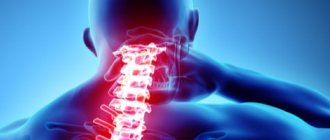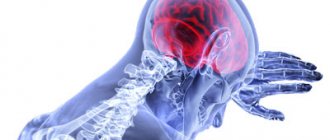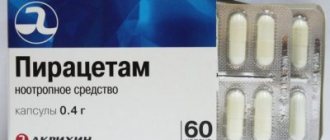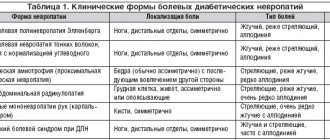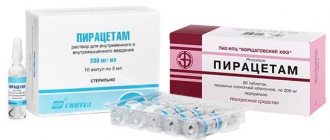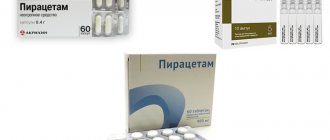Pharmacokinetics
When taken orally, it is quickly and almost completely absorbed from the gastrointestinal tract. Cmax in plasma is reached after approximately 30 minutes, in cerebrospinal fluid - after 2-8 hours. The apparent Vd is 0.6 l/kg. Does not bind to blood plasma proteins.
Distributed in all organs and tissues, penetrates the BBB and the placental barrier. Selectively accumulates in the tissues of the cerebral cortex, mainly in the frontal, parietal and occipital lobes, in the cerebellum and basal ganglia.
T1/2 from plasma is 4-5 hours, from cerebrospinal fluid - 6-8 hours. It is excreted unchanged by the kidneys. In renal failure, T1/2 increases.
T.S. Illarionova, Department of General and Clinical Pharmacology, RUDN University, Moscow
According to WHO definition, the group of nootropic drugs includes drugs that can have a direct activating effect on learning processes, improve memory and mental activity, and also increase the brain’s resistance to aggressive influences. Today, nootropic drugs are the most dynamically developing group of drugs and are in demand not only in neurology and psychiatry, but also in other areas of outpatient and hospital pharmacotherapy. Nootropic drugs multilaterally regulate higher thought processes in humans, in particular cognitive functions and cognitive abilities. A distinctive feature of nootropics is their amphotropism, i.e. the inability to influence higher nervous activity (HNA) and the human psyche under normal conditions and improve the course of these processes in the presence of existing functional or morphological disorders. They have a therapeutic effect as stimulators of the cognition process (cognition enhancers) only when mnestic functions are impaired, and not with a single or short-term administration, but after a long-term (at least 3-4 months) course of exposure.
Classification of nootropic drugs According to their chemical nature, nootropic drugs are derivatives of different chemical groups: • pyrrolidone derivatives (cyclic derivative of GABA, racetams); • g-aminobutyric acid (GABA); • g-hydroxybutyric acid (GHB); • homopantothenic acid (HOPA); • pyridoxine (vitamin B6); • aminoacetic acid; • chlorophenoxyacetic acid; • tryptamine (N-acetyl-5-ethoxytryptamine); • neuropeptides; • dipeptides; • vinca alkaloids; • other herbal products; • combined. Nootropic drugs can be divided into two large groups - these are direct-acting nootropics (with dominant mnestic effects) and neuroprotectors with nootropic effects (T.A. Voronina, S.B. Seredenin, 1998): 1. Nootropic drugs with a dominant mnestic effect ( cognitive enhancers): 1.1. Pyrrolidone nootropic drugs (racetams), predominantly of metabolite action (piracetam, oxiracetam, aniracetam, pramiracetam, etiracetam, dipracetam, rolisiracetam, nebracetam, isacetam, nefiracetam, detiracetam, etc.). 1.2. Cholinergic substances: 1.2.1. Activators of acetylcholine synthesis and its release (choline chloride, phosphatidyl-serine, lecithin, acetyl-L-carnitine, DUP-986, aminopyridine derivatives, ZK9346-betacarboline, etc.). 1.2.2. Agonists of cholinergic receptors (oxotremorine, bethanechol, pyropiperidines, quinonucleotides, etc.). 1.2.3. Acetylcholinesterase inhibitors (physostigmine, tacrine, amiridine, ertastigmine, galantamine, metrifonate, velnacrine maleate). 1.2.4. Substances with a mixed mechanism (demanol aceglumate, salbutamine, bifemelan, instenon). 1.3. Neuropeptides and their analogs (ACTH 1-10 and its fragments, ebiratide, somatostatin, Semax, vasopressin and its analogs, thyrotropin-releasing hormone and its analogs, neuropeptide Y, substance P, angiotensin-P, cholecystokinin-8, peptide analogs of piracetam (GVS-111 ), prolyl endopeptidase inhibitors). 1.4. Substances that affect the system of excitatory amino acids (glutamic acid, memantine, milacemide, glycerin, D-cycloserine, nooglutyl). 2. Mixed nootropic drugs with a wide range of effects (“neuroprotectors”): 2.1. Activators of brain metabolism (actovegin, acetyl-L-carnitine, carnitine, phosphatidyl, serine, homopantothenic acid esters, xanthine derivatives of pentoxifylline, propentofylline, tetrahydroquinolines). 2.2. Cerebral vasodilators (instenon, vincamine, vinpocetine, oxybral, nicergoline, vinconate, vindebumol). 2.3. Calcium antagonists (niludipine, cinnarizine, flunarizine, etc.). 2.4. Antioxidants (mexidol, exiphon, pyritinol, tirilazad mesilate, meclofenoxate, atherovit (alpha-tocopherol and meclofenoxate), etc.). 2.5. Substances affecting the GABA system (phenotropil, gammalon, hopantenic acid, picamilon, digam, nicotinamide, phenibut, sodium hydroxybutyrate, neurobutal, etc.). 2.6. Substances from different groups (etimizole, orotic acid, methyl glucoorotate, oxymetacyl, beglimin, naftidrofuryl, cerebrocrast, ginseng preparations, schisandra, ginkgo biloba extract, etc.).
Mechanisms of action of nootropic drugs In the mechanism of action of nootropic drugs, two main links can be distinguished: neurotransmitter and metabolic. Neurotransmitter mechanisms include the effect of the drug on the GABA, choline, glutamate or glycinergic systems. In this regard, the most promising are agonists of NMDA- (activated by N-methyl-d-aspartate) and AMPA- (activated by g-amino-3-hydroxy-5-methyl-isoxazole-4-proprionic acid) glutamine receptor subtypes and GABA-agonists. receptors, which are superior in potency to classic racetams (piracetam, pramiracetam, aniracetam), but these drugs can cause a number of serious side effects. Currently, the global pharmaceutical industry produces about 30 major nootropic drugs that have both positive therapeutic effects and side effects (see table). The history of the use of nootropic drugs began with the discovery of piracetam (2-oxo-1-pyrrolidone-acetamide, 1977) and, despite the shortcomings noted in the table, piracetam still remains the reference drug of this group. Currently, the family of pyrrolidone nootropics includes more than 10 original drugs, of which the best known are piracetam, oxiracetam, aniracetam, etiracetam and pramiracetam. Phenotropil became a fundamentally different representative of pyrrolidone derivatives. Unlike piracetam, Phenotropil has a phenyl radical, which determines a significant difference in the spectra of pharmacological activity of these drugs. Thus, the nootropic effect of the drug is detected already at a dose of 3.0 mg/kg, which is almost 72 times higher than the effect of piracetam. The antiamnestic effect of Phenotropil in doses of 25-100 mg/kg exceeds the effect of piracetam (300-1200 mg/kg) by 12.5-40 times. Phenotropil (50-300 mg/kg) is highly effective for all types of hypoxia (piracetam exhibits some antihypoxic effect only under conditions of hypobaric hypoxia, starting with a dose of 200 mg/kg). Thus, Phenotropil is a highly effective nootropic drug, significantly superior in activity to piracetam, which, unlike piracetam, has pronounced antihypoxic and anticonvulsant activity.
Clinical pharmacology of Phenotropil (N-Carbamoylmethyl-4-phenyl-2-pyrrolidone) When taken orally, Phenotropil is rapidly absorbed, penetrates various organs and tissues, easily passes through the blood-brain barrier, absolute bioavailability when taken orally is 100%. The maximum concentration in the blood is reached after an hour, the half-life is 3-5 hours. Phenotropil is not metabolized in the body and is excreted unchanged (40% in urine, 60% in bile and sweat). When used in doses of 6-750 mg/kg, Phenotropil has an anti-amnestic effect, a direct activating effect on the integrative activity of the brain, promotes memory consolidation, improves metabolic processes and regional blood flow in ischemic areas of the brain, restores speech and motor activity when they are impaired. When used in doses of 100-750 mg/kg, it increases the resistance of brain tissue to hypoxia and toxic effects, physical performance, the speed of information transfer between the hemispheres of the brain, improves concentration and mental activity, mood, facilitates the learning process, regulates the processes of activation and inhibition of the central nervous system. , has anxiolytic, anticonvulsant and anorexigenic effects (with course use). Phenotropil has a positive effect on metabolic processes and blood circulation in the brain, stimulates redox reactions, increases the body's energy potential through the utilization of glucose, and improves regional blood flow in ischemic areas of the brain. Increases the content of norepinephrine, dopamine and serotonin in the brain and does not have a noticeable effect on the spontaneous bioelectrical activity of the brain. The psychostimulating effect of the drug predominates in the ideational sphere. The moderate psychostimulating effect of the drug is combined with anxiolytic activity, improves mood, and has some analgesic effect, increasing the threshold of pain sensitivity. The adaptogenic effect of Phenotropil was convincingly proven in an experiment by V.I. Akhapkina and T.A. Voronina, it manifests itself in increasing the body’s resistance to stress under conditions of excessive mental and physical stress, fatigue, hypokinesia and immobilization, as well as at low temperatures (see figure). The undoubted advantage of the drug is its ability to have a sustained positive effect on cognitive functions in patients with a 10-day course of use, in contrast to all known nootropics (course - 3 months). A single use of Phenotropil in a dose of 100 mg as a functional state corrector is recommended for persons whose professional activities involve heavy mental and physical stress, as well as for protection against the damaging effects of the hypoxic factor. While taking the drug, there is an improvement in vision (sharpness, brightness, field expansion), and blood supply to the lower extremities. It stimulates the production of antibodies in response to the introduction of an antigen, which indicates its immunostimulating properties, but at the same time it does not contribute to the development of immediate hypersensitivity and does not change the allergic inflammatory reaction of the skin caused by the introduction of a foreign protein. With a course of use of the drug, drug dependence, tolerance, and “withdrawal syndrome” do not develop. The effect occurs with a single dose, which is important when used under extreme conditions. This drug does not have teratogenic, mutagenic, carcinogenic or embryotoxic properties. Toxicity – low, the lethal dose in an acute experiment is 800 mg/kg.
Conclusion The drug Phenotropil has a wide range of pharmacological effects and compares favorably with piracetam in a number of parameters: antiasthenic, psychostimulating, antidepressant, anti-aggressive, anorexigenic effect and increased physical performance are characteristic of Phenotropil, but are not observed when using piracetam. A significant advantage of Phenotropil is the speed of onset of the effect and the magnitude of the effective doses. Phenotropil acts already with a single injection, and the course of its use ranges from two weeks to two months, while the effect of most other representatives of the group of nootropics appears only after a course of treatment lasting from one to 6 months. The daily dose of Phenotropil is 0.1-0.3 g. Thus, Phenotropil can be classified as a new generation of nootropics with a unique spectrum of neuropsychotropic effects. The use of Phenotropil in medical practice will significantly improve the effectiveness of treatment and the quality of life of patients.
Literature 1. Avedisova A.S., Akhapkin R.V., Akhapkina V.I., Verigo N.N. Piracetam in the light of modern research (analysis of foreign studies) // Psychiatry and psychopharmacotherapy. 2000. T. 2. No. 6. P. 178-184. 2. Akhapkina V.I. Experimental and clinical pharmacology of the drug phenotropil / Abstracts of the XI Russian National Congress “Man and Medicine”. M., 2004. P. 70. 3. Akhapkina V.I., Voronina T.A. Spectrum of pharmacological effects of Phenotropil // Farmateka. 2005. No. 13. 4. Akhapkina V.I., Voronina T.A. Comparative characteristics of the nootropic activity of the drug phenotropil / Abstracts of the XI Russian National Congress “Man and Medicine”, M., 2004. P. 70-71. 5. Belenichev I.F., Mazur I.A., Voloshin N.A., Kovalenko S.I. // Fundamental problems of pharmacology. Collection of proceedings of the II Congress of the Russian Scientific Society of Pharmacologists. Moscow, 2003. pp. 63-64. 6. Belenichev I.F., Mazur I.A., Stets V.R., Sidorova I.V. Nootropic therapy: past, present, future // News of medicine and pharmacy. 2004. No. 14(155). P. 10. 7. Voronina T.A., Seredenin S.B. Nootropic drugs, achievements and new problems // Experimental and clinical pharmacology. 1998. T. 61. No. 4. P. 3-9. 8. Krieger D. // Journal of Neurology and Psychiatry. 2002. No. 3. P. 2-14. 9. Gustov A.A., Smirnov A.A., Korshunova Iu.A., Andrianova E.V. Phenotropil in the treatment of vascular encephalopathy // Zh Nevrol Psikhiatr Im SS Korsakova. 2006; 106(3):52-3. 10. Gerasimova MM, Chichanovskaia LV, Slezkina LA The clinical and immunological aspects of the effects of phenotropil on consequences of stroke // Zh Nevrol Psikhiatr Im SS Korsakova. 2005; 105(5):6314. 11. Savchenko A.Iu., Zakharova NS, Stepanov IN The phenotropil treatment of the consequences of brain organic lesions // Zh Nevrol Psikhiatr Im SS Korsakova. 2005; 105(12):22-6.
Drug interactions
A case of interaction of piracetam with simultaneous use with a thyroid extract containing triiodothyronine and tetraiodothyronine is described, when the patient experienced anxiety, irritability and sleep disorders.
When used simultaneously with thyroid hormones, the development of central effects is possible - tremor, anxiety, irritability, sleep disturbances, confusion.
With the simultaneous use of central nervous system stimulants, the psychostimulating effect may be enhanced.
When used simultaneously with antipsychotics, an increase in extrapyramidal disorders is observed.
Pregnancy and lactation
Adequate and strictly controlled studies of the safety of piracetam during pregnancy have not been conducted. Use is possible only in cases where the expected benefit to the mother outweighs the possible risk to the fetus.
Piracetam appears to pass into breast milk. If it is necessary to use it during lactation, the issue of stopping breastfeeding should be decided.
Experimental studies on animals did not reveal any negative effects of piracetam on the fetus.
Nootropil or phenotropil: which is better, reviews
Reviews about nootropil are, in most cases, positive, but there are also negative statements.
Among the positive characteristics are:
- affordable price;
- possibility of use for children;
- convenient form of release: solution and injection.
The following are the negative points:
- the need for long-term use of the drug;
- the presence of adverse reactions in children and elderly patients.
Reviews about phenotropil are also contradictory. Positive sides:
- good tolerance;
- provides quick effect;
- can be taken once to improve the condition.
Negative points:
- high cost of the drug;
- causes insomnia.
The disadvantages of phenotropil also include the fact that it cannot be used for a long course, since the drug is addictive. After a certain time, the product will not have a positive effect.
Answering the question, phenotropil and nootropil: what is the difference, you can now understand this based on the base of numerous statements about one and another medication. The main thing is that you cannot use medications on your own; they must be recommended by a specialist.
